We have grand-fathered our support for syncing GroupWise.
Audience: Project Team Lead, End-User Evaluation Team, and Riva Administrators.
(For a similar article intended for end users, see How Does Riva Sync Your CRM and GroupWise Data.)
Objectives and the means to reach them
- To glimpse some of Riva's many sync options, look at Riva sync policy screenshots.
- To start planning your Riva sync policy to achieve your syncing goals, ask yourself questions.
We recommend that, while working through this article, you also keep referring to Create and configure a sync policy for GroupWise.
Main sections
Which Users Do You Want Riva to Sync?

Riva supports assigning target users to the sync policy by using mailbox users or GroupWise enabled groups. If a large number of users will be added to a sync policy, it is easier to use groups. User management would be done in eDirectory. Changes to group member lists will be picked up once daily or if the Riva sync service is restarted.
Riva also supports syncing multiple sync policies at the same time. This allows Riva administrators to design sync policies that best meet sync requirements based on the type of user (in an office or mobile), geographic location (North America, EMEA, APAC, etc.), or type of data being synced (full data sync, calendar only, email only, etc.).
Key questions to ask about users
-
Q1: How many users will be synced in production?
-
Q2: Is there a requirement for different sync policies?
-
Q3: Will users be moved between sync policies? How often will this occur?
How Far into the Past Do You Want to Go?
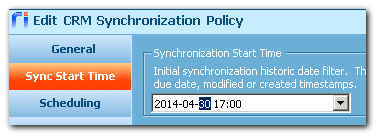
When Riva performs a first time sync for a user, it queries the CRM for contacts, leads, calendar items, and tasks to copy to the user's GroupWise mailbox. Riva includes a Sync Start Time filter option that Riva applies depending on the type of data.
- Contacts and Leads are filtered based on create or last modified date. Items created or last modified before the Sync Start Time filter are not copied to a user's address book.
- Calendar items are filtered against the schedule start date. Items scheduled to start before the Sync Start Time filter are not copied to the user's Riva-created child calendar.
- Tasks are filtered based on the scheduled start date or, if a start date is not specified in the task, the filtering is based on the create or last modified date. Items scheduled to start before the Sync Start Time filter are not copied to the user's to-do task list. Items with no start date and created or last modified before the Sync Start Time filter are not copied to the user's to-do task list.
Key questions to ask about the sync start time
-
Q1: How far back into the past do you want to query the CRM to select contacts, leads, calendar items, and tasks to sync to the user's mailbox?
-
Q2: Do you want to set a different Sync Start Time filter for the address book, the calendar, and task items?
How Do You Want Riva to Sync Your Contacts and Leads?
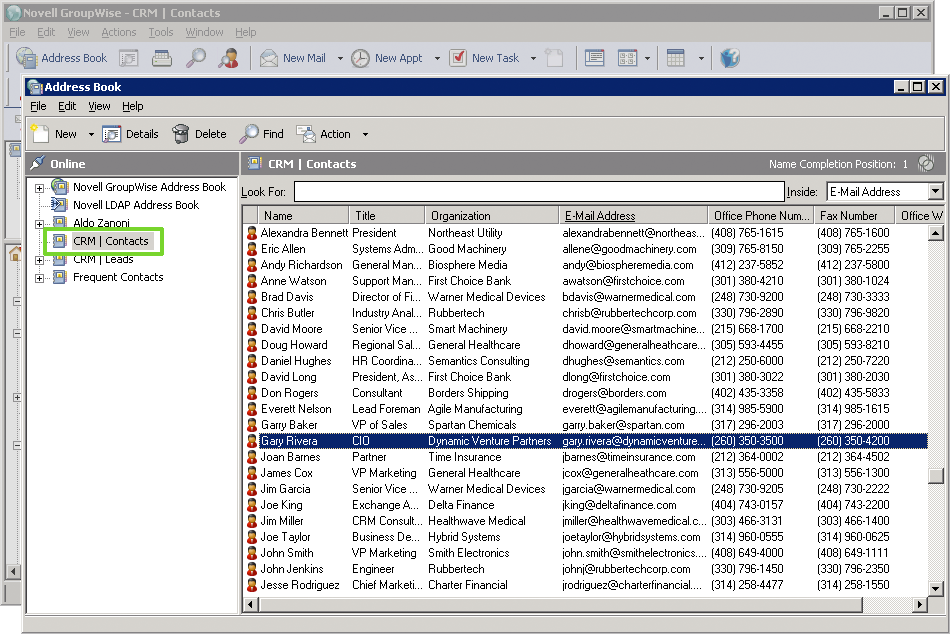
Sync CRM Contacts to the GroupWise Address Book
Syncing contact and lead data
First Time Sync: Once a user has been added to a sync policy and Riva runs a first time sync against that user, Riva syncs a filtered list of contacts and leads from the CRM and creates those as contact records in the GroupWise Address Book:
- CRM Contacts and Accounts are created as contact and org records in a Riva-created address book that is named using the Riva category name, for example Company CRM | Contacts.
Normal Data Sync: Riva can support bidirectional or unidirectional data syncing between the CRM and GroupWise. When bidirectional syncing is enabled, Riva syncs contacts, accounts and leads as follows:
- If "Synchronize Contacts" is checked, Riva syncs created, modified, and deleted contacts from the CRM to GroupWise into an address book that is named as [Category Name | Contacts] e.g. Company CRM | Contacts.
- If "Synchronize Organizations" is checked, Riva will create an organization record for each CRM account record (based on how the items are filtered) into the Category Name | Contacts address book.
- If "Synchronize Leads" is checked, Riva syncs created, modified, and deleted contacts (based on how items are filtered) from the CRM to GroupWise into an address book that is named as [Category Name | Leads] e.g. Company CRM | Leads.
- Riva syncs created and modified contact and lead records from GroupWise to the CRM. By default, Riva does not sync deleted GroupWise contacts or leads to the CRM, because Riva considers the CRM contact, lead, and account records as authoritative over email records.
- Riva automatically syncs contact and lead changes in both directions.
- All contact records in GroupWise that Riva has synced with the CRM are categorized in GroupWise with a Riva-created category.
- Riva can filter contact sync based on visibility in the CRM or ownership of the contact record in the CRM, and creation or modification dates of contact records.
Key questions to ask about contacts and leads
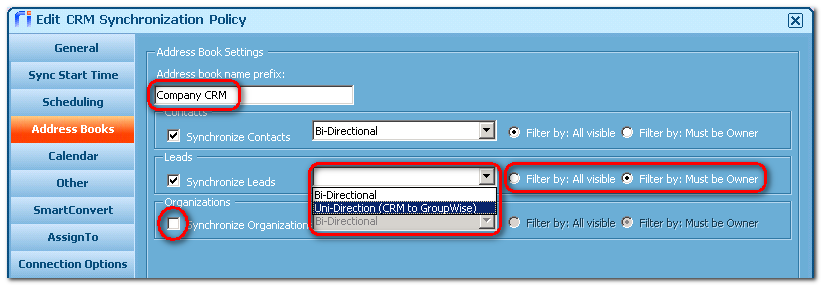
-
Q1: Do you want Riva to sync contacts?
-
Q2: Do you want Riva to sync leads?
-
Q3: Do you want bidirectional sync or unidirectional CRM to GroupWise sync?
-
Q4: What category name do you want to use to sync contacts and leads?
-
Q5: Do you want to Riva to filter CRM contacts and leads by all visible or ownership, or apply a custom filter?
How Do You Want Riva to Sync Your Calendar Events?
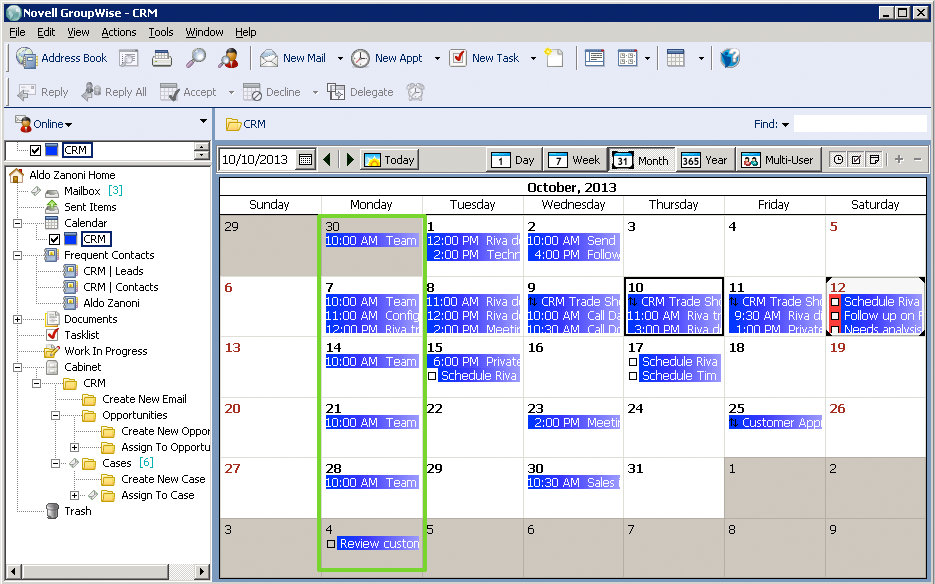
Sync CRM Calendar Items to the GroupWise Calendar
First Time Sync: Once a user has been added to a sync policy and Riva runs a first time sync against that user, Riva syncs calendar items from the CRM and creates those as calendar items in a child calendar in GroupWise that matches the category name specified in the sync policy.
Normal Data Sync: Riva supports bidirectional and unidirectional data syncing between the CRM and GroupWise. When bidirectional syncing is enabled, Riva syncs the calendar as follows:
- Riva syncs created, modified, and deleted appointments, events (meetings), phone calls, and service calls (for Microsoft Dynamics CRM only) from the CRM to Exchange.
- Riva syncs created, modified, and deleted appointments and meetings from Exchange to the CRM.
- Riva automatically syncs calendar changes from the CRM to Exchange.
- Riva can be configured to require a Riva category to be applied to an Exchange calendar item before Riva syncs that item to the CRM.
- Riva can be configured to ignore private appointments and can treat CRM deletions as cancellations in Exchange. For example, if a user deletes a calendar item in CRM, Riva syncs it to Exchange and modifies the title of the calendar item to show "Deleted in CRM".
- Riva syncs recurring appointments from the CRM to Exchange (if supported by the CRM).
- Riva syncs Exchange recurring appointments and meetings to the CRM and creates individual calendar items in the CRM.
Note: Riva does not sync marking CRM calendar items as "completed" to Exchange.
Key questions to ask about calendar events

-
Q1: Do you want Riva to sync appointments, phone calls, and/or service calls (Microsoft Dynamics CRM only)? Do you want bidirectional sync or unidirectional CRM to Exchange sync?
-
Q2: What category name and colour do you want to use for calendar items?
How Do You Want Riva to Sync Your Tasks?
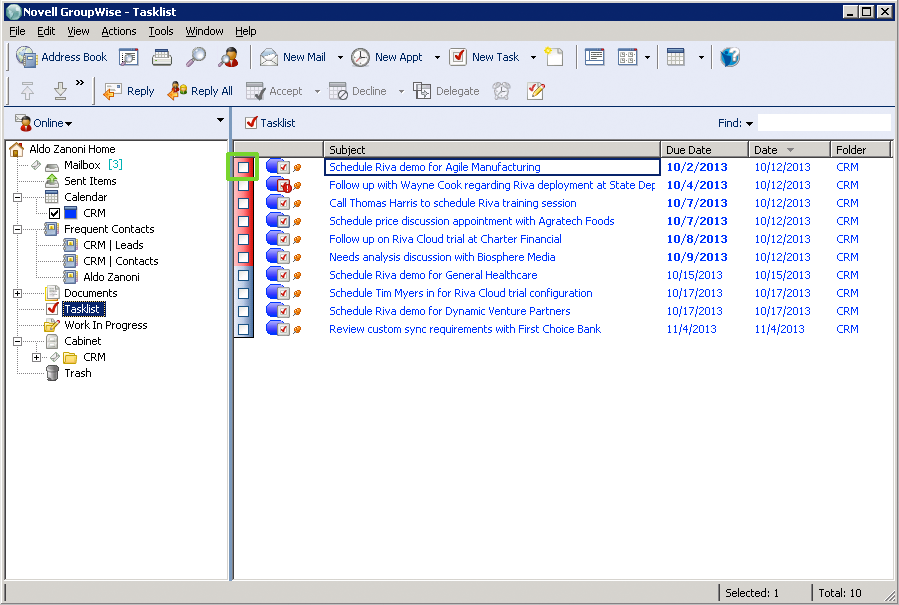
Sync CRM Tasks to the GroupWise Tasklist
First Time Sync: Once a user has been added to a sync policy and Riva runs a first time sync against that user, Riva will sync task items from the CRM and create those as tasks items in the user's Tasklist in GroupWise. Those task items will appear in the user's GroupWise Tasklist and be colour-coded according to the Calendar page of the sync policy.
Normal Data Sync: Riva supports bidirectional and unidirectional data syncing between the CRM and GroupWise. When bidirectional syncing is enabled, Riva syncs tasks as follows:
- Riva syncs created, modified, status-updated, and deleted tasks in both directions.
- If a task is marked as "completed", Riva syncs it as an update and changes the status to "completed" in the corresponding system. Once marked as "completed", Riva stops syncing any changes to the task item.
- Riva automatically syncs task changes from the CRM to GroupWise.
- Users need to create new tasks to sync to the CRM in the child calendar in the Day view in the To-Do list. It is recommended that users create new tasks in the CRM.
Key questions to ask about tasks

How Do You Want Riva to Sync Your Email to the CRM?
Riva can sync email in various ways.
From the CRM to the email system:
From the email system to the CRM:
Note: Riva does not sync emails created in the CRM into GroupWise.
Riva creates summary emails to represent CRM module data (like opportunities)
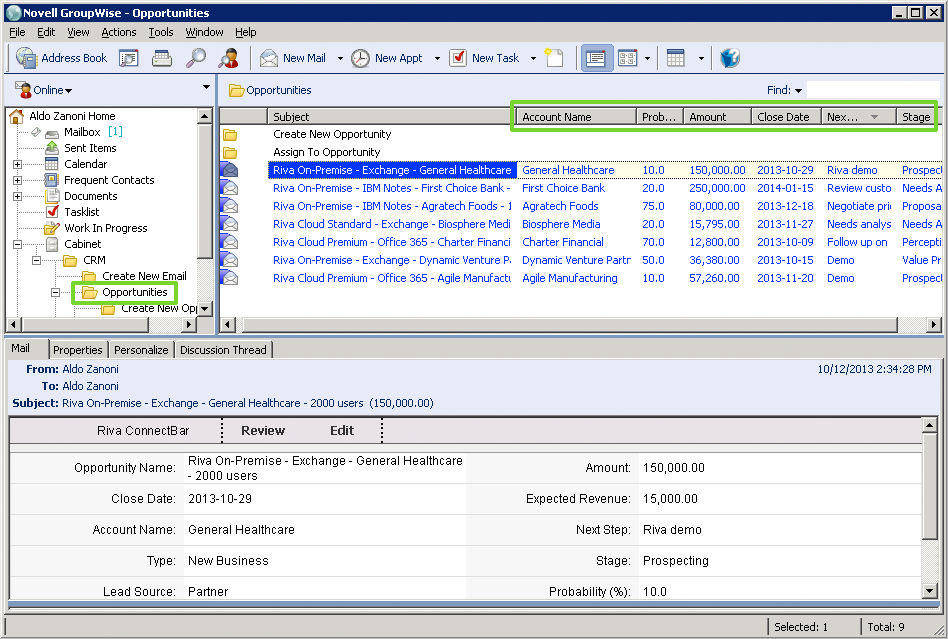
Sync CRM opportunities, cases, and custom objects between the CRM and GroupWise
Normal Data Sync: Riva creates summary emails in the Exchange mailbox in the module folders of the drop folder structure, for example the Opportunities folder. Those emails contain summary information about each active module item (for example, an opportunity). Each email also includes a button or website link to open the module item in the CRM in either Edit or View mode.
Key questions to ask about syncing CRM module data

-
Q1: Do you want to sync summary emails by module?
-
Q2: Which modules do you want to sync summary emails for? Quotes, opportunities, cases, projects, etc. (supported modules varies with each Vendor CRM)?
-
Q3: How do you want to filter summary emails? "Filter by: All visible" or "Filter by: Must be Owner"?
Riva archives email against CRM users, contacts, or leads
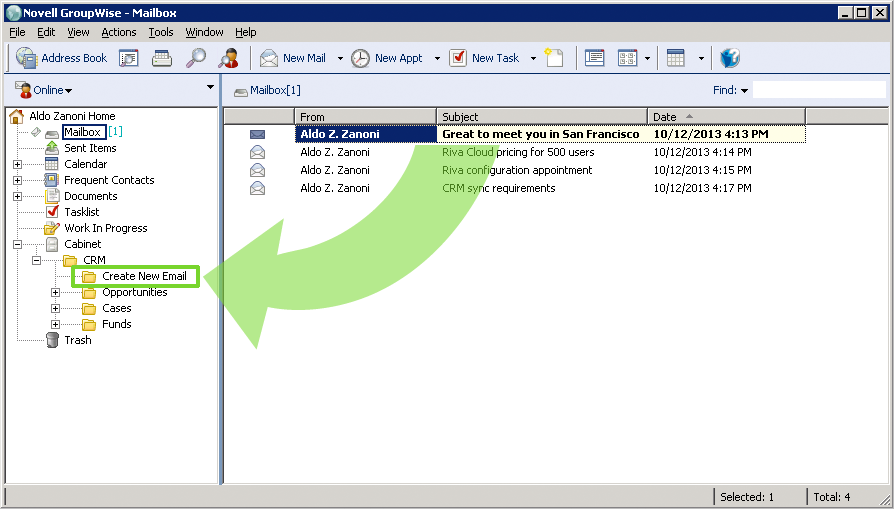
Track emails to the CRM contacts using drag and link to the "Create New Email" folder
First Time Sync: During the first sync, Riva builds, in the user's mailbox, a new folder structure that contains "drop folders". A user can sync an email to the CRM by moving it or copying it into an appropriate "drop folder".
Normal Data Sync: By default, Riva archives emails and matches the email recipients to the CRM user first, then to CRM contacts, and then to CRM leads (if enabled in the sync policy). Riva can be configured to sync emails and create module items in the CRM, typically new opportunities, cases, projects, or quotes. Riva also supports custom objects for some CRMs. For each email placed in a "drop folder", Riva archives it to the CRM as follows:
- Riva attempts to match each email recipient and the sender to CRM users. If no match is found, Riva attempts to match to CRM contacts. If no match is found, Riva checks against leads (if configured to do so).
- If a match is not found, Riva attempts to create a contact (or lead if configured to do so). For a new contact, Riva tries to match the new contact to an existing CRM account by matching the Company field to CRM account names, then by email domain name (for example, @example.com) to the website field or email address field of CRM account records. If a match is found, the new contact is created and related to the existing CRM account. If no match is made, Riva creates a new account using the Company name field or email domain name, depending on how the sync policy is configured.
- For most CRMs, Riva creates an email item. For some, like Salesforce, Riva creates an activity item that appears as a completed task if matched to a CRM contact or lead, or as an uncompleted task if matched to a system user.
- Riva moves the email from the drop folder back to either the Inbox or the Sent Items folder and assigns the Processing Complete! category to the email.
The SmartConvert tab of the sync policy has many options that control how email sync is implemented.
Key questions to ask about syncing emails
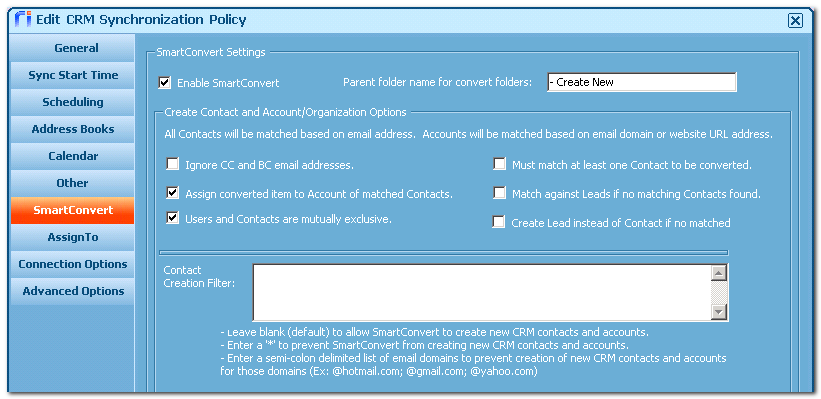
-
Q1: Do you want to enable email sync?
-
Q2: Do you require that emails must match an existing CRM contact or lead in order to archive them to the CRM? (Such a required match prevents archiving internal emails.)
-
Q3: Do you want to match CC and BC recipients against CRM users, contacts, or leads?
-
Q4: Do you want to disable all contact, lead, and account creation in the CRM?
-
Q5: If you allow the creation of CRM contacts and/or leads, do you want to edit the creation filter to filter out certain domain names like your company domain names? (This filtering prevents creating employee contacts.)
-
Q6: If no matching contact is found, do you want to match against CRM leads?
-
Q7: If the recipient is not matched, do you want to create CRM leads instead of CRM contacts?
-
Q8: Do you want to CRM user and contact matching to be mutually exclusive? (This prevents matching recipients to both a CRM user and a CRM employee contact record.)
-
Q9: Are there any specific special filters or custom categories that need to be supported?
Use email to create CRM module items, like opportunities or cases
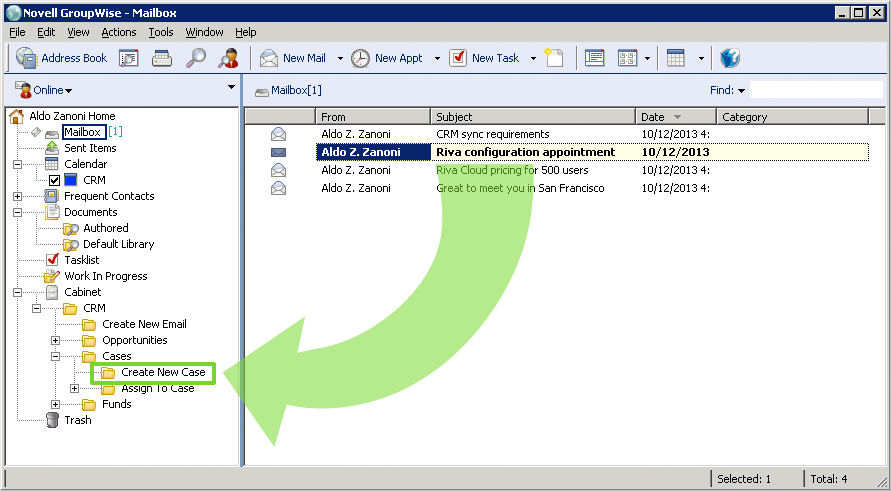
Use SmartConvert to convert an email into a new CRM case
First Time Sync: During the first sync, Riva builds, in the user's mailbox, a new folder structure that contains "drop folders". Drop folders (for example, "- Create New Opportunity") are added for each module that is enabled in the Other tab of the sync policy.
Normal Data Sync: When a user places an email in a "- Create New [module]" folder, Riva processes that email as follows:
- Riva attempts to match recipients to CRM users, contacts, and leads. The matching process is the same as when Syncing emails to the CRM.
- Riva creates a module item (for example, a new opportunity) in the CRM and assigns it to the user that Riva is syncing.
- Riva adds the email to the Activity History of the new module item and of the matched contacts and leads.
- Riva syncs a new summary email back to the parent module folder; for example, Riva syncs a summary email back to the Opportunities folder.
- If AssignTo is enabled (see Use AssignTo to archive email against existing opportunities and cases), Riva syncs a new email drop folder for the new item. For example, Riva creates a new opportunity drop folder under the \Opportunities\Assign To\ folder).
- Riva moves the email back to the Inbox or Sent Items folder and assigns the Processing Complete! category to the email.
Key question to ask about SmartConvert
- Q1: For which modules do you want to see a "- Create New [module item]" drop folder, where you can drop emails for Riva to create corresponding module items in the CRM? (For each one of them, be sure to clear the Hide check box.)
Riva archives email against CRM module items, like opportunities, cases, or projects
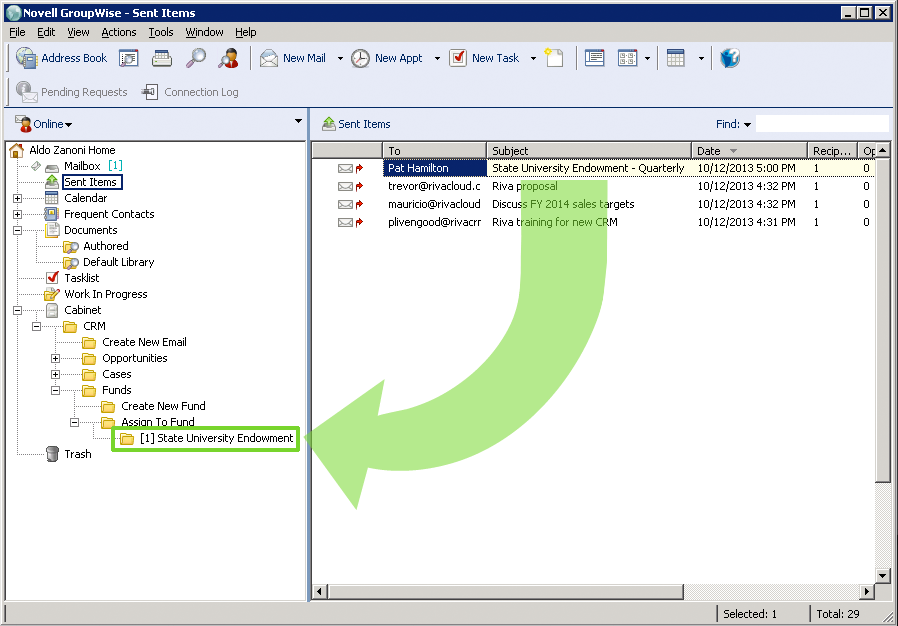
Use AssignTo to archive emails against existing opportunities, cases, or custom modules
First Time Sync: During the first sync, Riva adds an \Assign To\ folder under the parent module folder for each module enabled in the Other tab of the sync policy. Riva adds a drop folder for each active module item that is either visible to or owned by the user. The folder name is based on the module item:
-
Opportunity folder names include an index number, the title of the opportunity, and the value of the opportunity.
Example: \Opportunities\Assign To\[1] 3000 Widgets for Acme Corp ($120,000)
-
Case folder names include an index number, the case number, and the title of the case.
Example: \Cases\Assign To\[1] [12934] Widget control not activating automatically on restart
Normal Data Sync: When a user places an email in an AssignTo drop folder, Riva processes that email as follows:
- Riva attempts to match recipients to CRM users, contacts, and leads. The matching process is the same as when Syncing emails to the CRM.
- Riva adds the email to the Activity History of the existing module item and of the matched contacts and leads.
- Riva syncs an update to the summary email back to the parent module folder. For example, Riva syncs a summary email back to the Opportunities folder.
- Riva moves the email back to the Inbox or Sent Items folder and assigns the Processing Complete! category to the email.
Key questions to ask about AssignTo
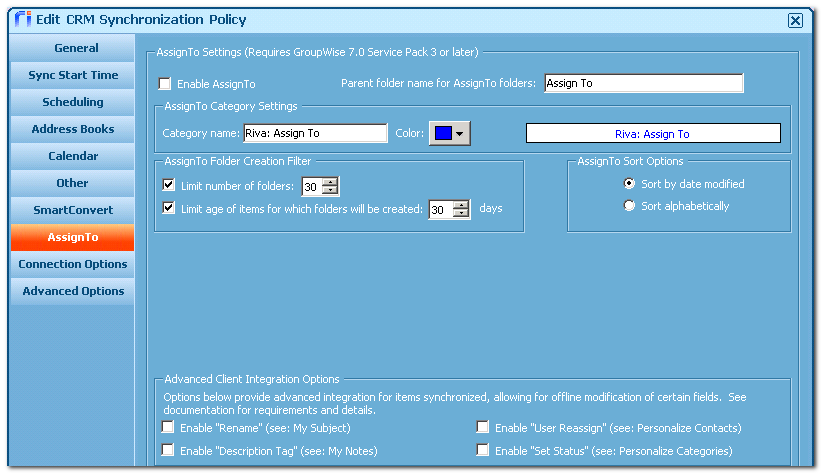
-
Q1: Do you want to enable AssignTo, so as to archive emails to existing modules?
-
Q2: Do you want to limit the number of drop folders created in the AssignTo folder? (By default, there is a 30-folder limit.)
-
Q3: Do you want to limit the age of items for which drop folders are created and retained? (This option automatically removes drop folders for stale items.)
-
Q4: How do you want your email client to sort your AssignTo drop folders? By date modified, alphabetically, or—for cases—by ascending case number?

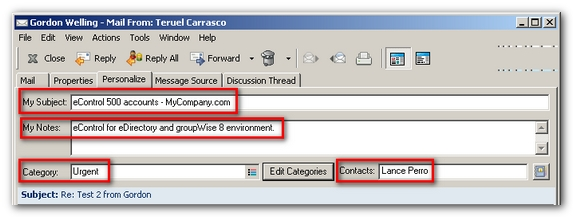
-
Q1: Do you want to enable AssignTo, so as to archive emails to existing modules?
-
Q2: Do you want to limit the number of drop folders created in the AssignTo folder? (By default, there is a 30-folder limit.)
















